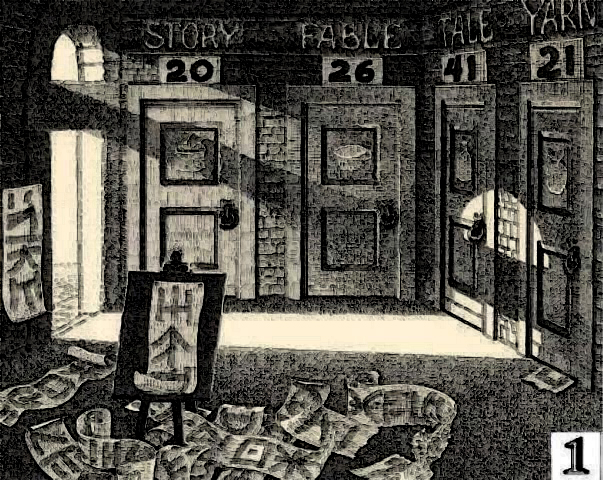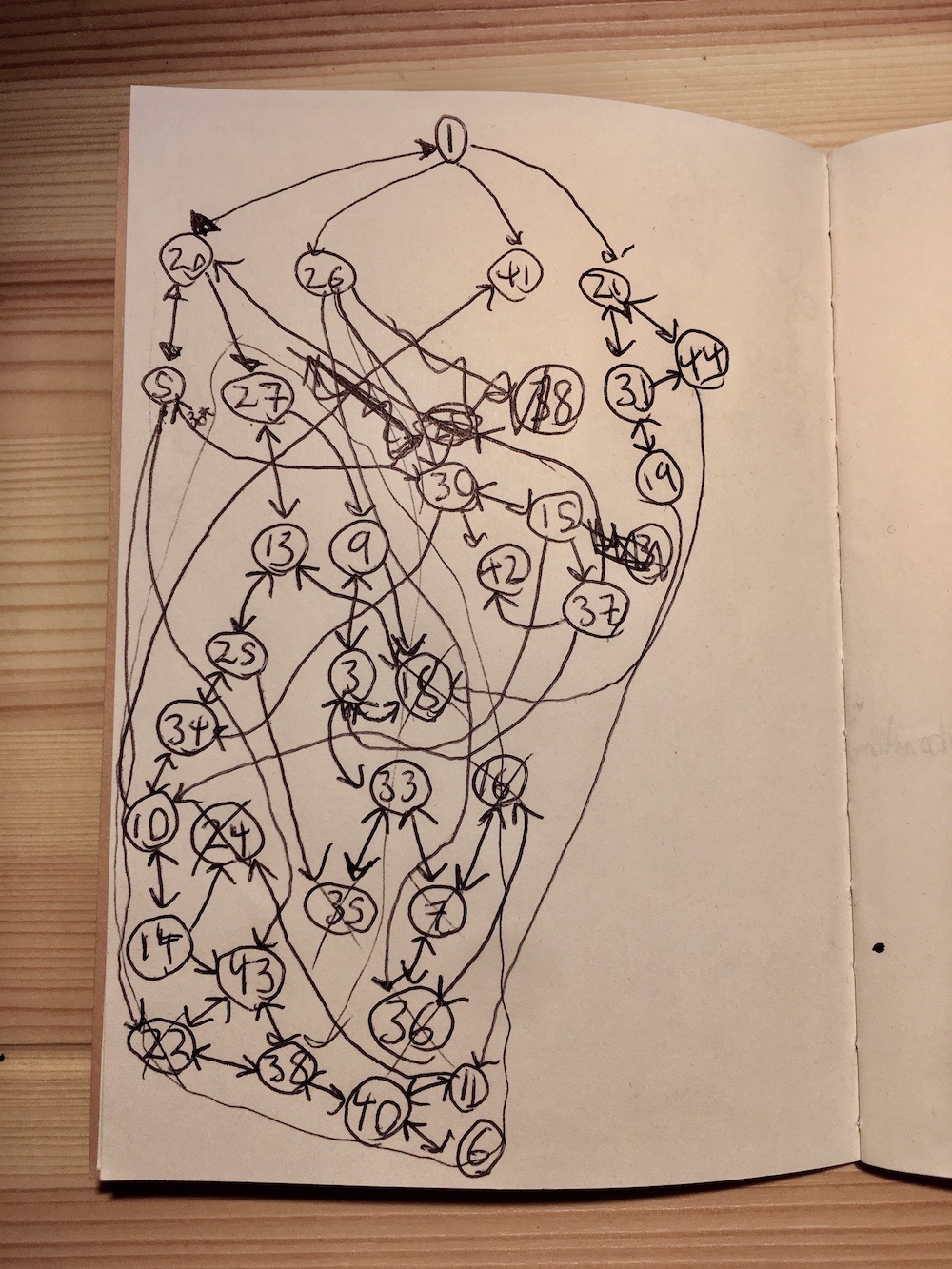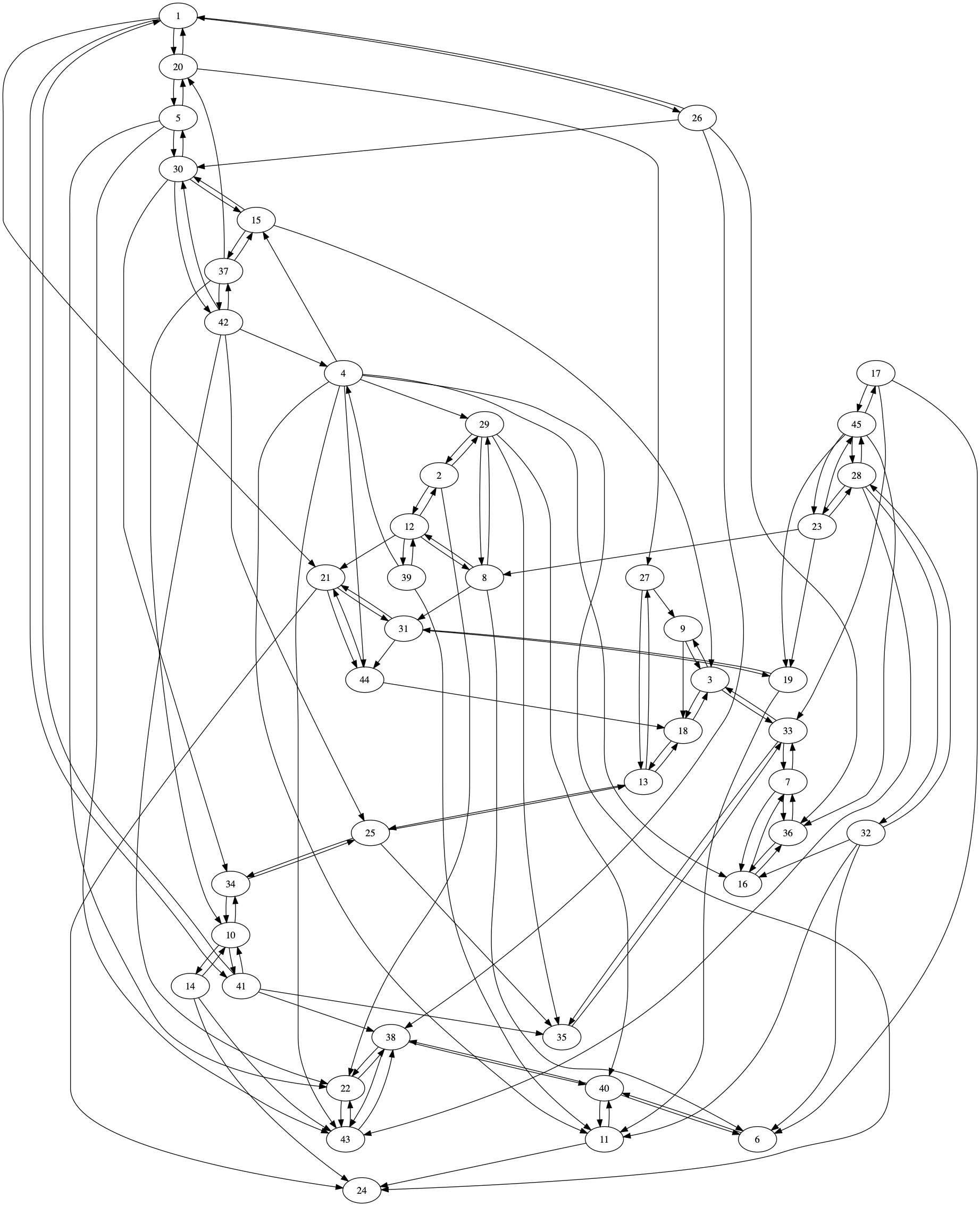MAZE: Solving "the World's Most Challenging Puzzle" with Python
Nov 9, 2019
Nov 9, 2019
When I was a kid I had a unique and interesting book called MAZE: Solve the World’s Most Challenging Puzzle. I recently solved the puzzle (or at least the first, easiest part of it) by writing a program. I thought that applying programming to it would rob the book of some of its magic, but it actually made it feel more magical! Read on to find out how.
The book itself is nonlinear—sort of like the choose-your-own-adventure books that were also popular when I was a kid. Each page has an illustration depicting a room in the titular maze, and containing numbered doors that you can use to go to other rooms/pages. For example, here’s room 1, the entrance to the maze:

To take the door to room 20, you simply turn to page 20, which will also have numbered doors in it. By doing this repeatedly, you “navigate” through the maze. To get a feel for what it’s like, you can explore an online version of the book here.
The goal is to find your way from room 1 to the room at the center of the maze (room 45) and back in only sixteen steps (this is the easy part of the puzzle, which I solved). Then, once you’ve done that, answer the riddle hidden in the illustration of room 45, using the clues hidden along the path there and back (this is the hard part, which no one has solved yet).
In addition to the central puzzle, the eerie, painstakingly crafted woodcut illustrations and sparse but evocative descriptions of each room are also delightful in their own right. The book is full of allusions to fables and fairytales, gothic architecture, furtive clues, and mysterious symbolism. Reading (playing?) it feels like stepping into a Hans Christian Anderson story or a Guillermo del Toro movie.
My childhood copy was lost long ago, but a couple of very kind friends got me another as a gift after I mentioned it to them. I never solved the maze as a kid, and I was excited to try as an adult!
I started out by just wandering among the rooms more or less at random, basking in nostalgia. This was fun, but I quickly realized I was never going to solve the maze this way.
I moved on to trying to “map” the maze using a pen and paper. As I explored, I kept track of where I’d been by drawing circles for rooms and lines between them for doors, building a graph of the maze in the process:

As you can see, this got messy fast. It was still useful though, because it led me to the surprising conclusion that room 45 is unreachable from room 1! I was fairly confident I had mapped out every possible path, and as you can see in the picture, room 45 is nowhere to be found.
I was flummoxed. A natural next step would have been to turn to computers, since a graph search algorithm could tell me very quickly if I was right. But I felt that his would be cheating somehow—like it would rob the book of some of it’s magic. My friend Rachel eventually convinced me that was silly, and she was right! I decided to write some programs to help me out.
The first thing I did was to go through the book one page at a time and transcribe all the connections between rooms into a graph written in the DOT graph description language. It looked something like this1:
digraph maze{
1 -> 20;
1 -> 26;
1 -> 41;
1 -> 21;
2 -> 29;
...
}
DOT files can be parsed by all sorts of graph processing and
visualization tools, so representing the maze this way is a good
starting point. digraph means that the edges in this graph have a
direction (i.e. just because you can go from room X to room Y doesn’t
mean you can go from Y back to X). The line 1 -> 20; means that you
can reach room 20 from room 1, and so on.
Next, I used graphviz to draw a picture of the graph:

Not much better than my hand-drawn map, but it is a nice visualization of some things about the structure of the maze that you feel intuitively while playing it. For example, that there are “clusters” of three rooms that form tight loops with each other (e.g. 7-36-16, or 38-22-43).
Next, I wanted to confirm my suspicion that room 45 is not reachable from room 1. To do this, I used NetworkX:
import networkx as nx
import pydot
g = nx.drawing.nx_pydot.read_dot("maze.dot")
nx.shortest_path(g, "1", "45")
This throws an error: NetworkXNoPath: No path between 1 and 45. So
indeed, no such path exists! What could be going on?
It dawned on me that there must be a “hidden door” somewhere in the maze, connecting two rooms that don’t at first appear to be connected, and discoverable only by careful examination of the illustrations. This was already really cool and made the book feel more magical! I’d never suspected that it had something like this in it, and I never would have figured it out if a graph search algorithm hadn’t convinced me it must be true.
Next, I wrote a small program that helped me find the hidden door. Spoiler warning: stop reading here if you’d like to try to figure it out on your own.
OK, how to find the the hidden door? Well, we know from the book’s marketing copy that the path from the beginning to the end of the maze and back has exactly sixteen steps. We can also see that while there doesn’t seem to be a path from the beginning to the end, there is a path back, and it’s nine steps long:
>>> nx.shortest_path(g, "45", "1")
['45', '23', '8', '12', '39', '4', '15', '37', '20', '1']
This means the path there is seven steps long2.
We can also see from looking at the DOT file (or just flipping through the pages of the book) that there are only three rooms that have doors leading to room 45: 17, 23, and 28. This means the hidden door must either lead into one of these rooms, or lead into room 45 directly3.
All of this suggests an algorithm for finding the hidden door:
In Python code, this looks like:
for e in nx.non_edges(g):
if e[1] not in ["17", "23", "28", "45"]:
continue
g.add_edge(*e)
try:
path = nx.shortest_path(g, "1", "45")
if len(path)-1 == 7:
print(e)
except:
pass
g.remove_edge(*e)
Running it prints all the candidate edges:
('2', '45')
('29', '17')
('29', '23')
('29', '28')
('8', '45')
NetworkX represents edges as tuples, so ('2', '45') means an edge
from node 2 to node 45 (i.e. a door from room 2 to room 45).
This is a small enough list of candidates that we can just look at the illustrations of rooms 2, 8, and 29 by hand to see which one might have the hidden door in it! Rooms 2 and 8 aren’t very interesting but let’s look closely at room 29, looking for a hidden door into room 17, 23, or 28:

Aha! There’s a door to room 17 hidden behind the curtain, the characters in this room just took off the sign for it, turned it upside down, and used it as a candelabra!
In hindsight, there are lots of clues in this room that point to this. For instance, one of the characters is upside down, indicating we’re looking for something upside down. Also, the sign reading “Directions: Up And On” could indicate that we need to turn something right-side up in order to move on.
Adding this edge to the graph gives us the complete path through the maze:
>>> g.add_edge("29", "17")
>>> nx.shortest_path(g, "1", "45") + nx.shortest_path(g, "45", "1")
['1', '26', '30', '42', '4', '29', '17', '45', '45', '23', '8', '12',
'39', '4', '15', '37', '20', '1']
There and back again in sixteen steps! You can follow this path yourself in the book or online to verify that it’s correct.
I was pleasantly surprised that using a computer to solve the puzzle actually added the magical aura of the book for me, rather than taking away from it. The presence of the hidden door is so charming, and I probably never would have discovered it without writing a program to help me.
Anyway, the title of this post is sort of clickbait. I did use Python to find the path through the maze, but that’s far from “the world’s hardest puzzle”. When the book was first published in 1985, the hidden door and the path through the maze were discovered quickly. The “world’s hardest puzzle” part is finding and answering the riddle hidden in the illustrations, which still to this day no one has done!
If you want to learn more about the book and see all the work that its small but dedicated community of fans has put into solving it, check out Into the Abyss, a delightful website lovingly maintained by a devotee known only as “White Raven”. It has extensive documentation, lore, and discussion about MAZE, and people still post on it regularly with new ideas and theories about how to decipher the book’s mysteries.
You can find a Jupyter notebook containing the code from this post, as well as the DOT file representing the maze here.
You can download the full DOT file, representing the entire maze, here. ↩︎
This isn’t necessarily true, in that the hidden door could somehow create a path to the end and a new path back, but that just seemed unlikely so I decided to run with the assumption that hidden door only created the forward path, leaving the path back unchanged. ↩︎
You might be thinking “wait, couldn’t it also connect two rooms elsewhere in the maze that somehow create a path to room 45?”. It can’t, since any such path would have to go through room 17, 23, or 28—but we know these rooms aren’t reachable from room 1, since if they were, there would already be a path to the end! The only way for them to become reachable is if the hidden door leads to one of them. ↩︎